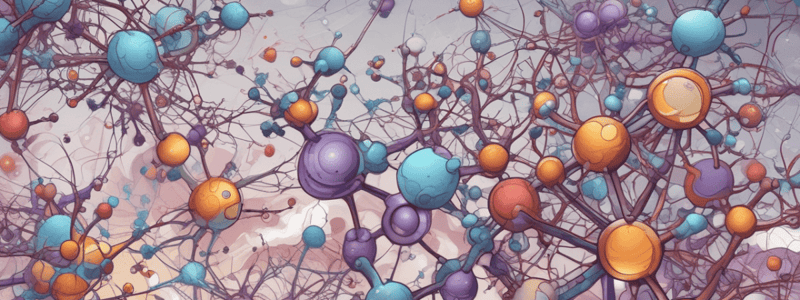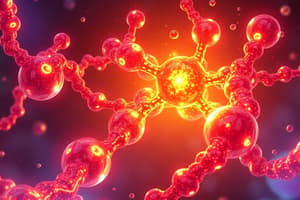Podcast
Questions and Answers
What fundamental principle is conserved during chemical transformations in living organisms?
What fundamental principle is conserved during chemical transformations in living organisms?
- Volume and temperature
- Mass and energy (correct)
- Pressure and concentration
- Chemical potential and pH
Which reaction example is a slow chemical reaction?
Which reaction example is a slow chemical reaction?
- Combination of iron and oxygen to form rust (correct)
- Combustion of gasoline
- Metabolism of glucose in cells
- Photosynthesis in plants
What are the starting substances in a chemical reaction called?
What are the starting substances in a chemical reaction called?
- Catalysts
- Products
- Reactants (correct)
- Enzymes
Which of these is necessary for a chemical reaction to occur if it absorbs energy?
Which of these is necessary for a chemical reaction to occur if it absorbs energy?
Which statement about energy in chemical reactions is correct?
Which statement about energy in chemical reactions is correct?
What term describes the substances produced by a chemical reaction?
What term describes the substances produced by a chemical reaction?
What is an example of an organism's interaction with the environment being based on chemical reactions?
What is an example of an organism's interaction with the environment being based on chemical reactions?
Which statement is true about chemical reactions that occur spontaneously?
Which statement is true about chemical reactions that occur spontaneously?
What is the primary role of enzymes in living organisms?
What is the primary role of enzymes in living organisms?
What substrate does the enzyme carbonic anhydrase act on in the reaction depicted?
What substrate does the enzyme carbonic anhydrase act on in the reaction depicted?
Why are enzymes highly specific in the reactions they catalyze?
Why are enzymes highly specific in the reactions they catalyze?
How do enzymes affect the activation energy of a chemical reaction?
How do enzymes affect the activation energy of a chemical reaction?
Which of the following best describes metabolism?
Which of the following best describes metabolism?
What happens to reactants if they do not have enough energy in an enzyme-catalyzed reaction?
What happens to reactants if they do not have enough energy in an enzyme-catalyzed reaction?
What type of reaction is catalyzed by catalytic enzymes?
What type of reaction is catalyzed by catalytic enzymes?
What is created temporarily when an enzyme binds to its substrate?
What is created temporarily when an enzyme binds to its substrate?
What is the term for the energy required to initiate a chemical reaction?
What is the term for the energy required to initiate a chemical reaction?
What generally describes the energy comparison between reactants and products in an energy-releasing reaction?
What generally describes the energy comparison between reactants and products in an energy-releasing reaction?
How do organisms obtain the energy necessary for vital functions such as making new cells and moving?
How do organisms obtain the energy necessary for vital functions such as making new cells and moving?
Which of the following describes a characteristic of chemical reactions that release energy?
Which of the following describes a characteristic of chemical reactions that release energy?
What occurs during a chemical reaction when the reactant particles collide with sufficient energy?
What occurs during a chemical reaction when the reactant particles collide with sufficient energy?
Which statement correctly identifies a property of energy-absorbing reactions?
Which statement correctly identifies a property of energy-absorbing reactions?
What is the primary function of catalase in cells?
What is the primary function of catalase in cells?
Which type of bond predominantly holds the substrates to the enzyme's active site?
Which type of bond predominantly holds the substrates to the enzyme's active site?
Why do enzymes produced by human cells generally work best at temperatures close to 37°C?
Why do enzymes produced by human cells generally work best at temperatures close to 37°C?
Which condition is most likely to cause an enzyme to denature?
Which condition is most likely to cause an enzyme to denature?
What role do enzymes play in a chemical reaction?
What role do enzymes play in a chemical reaction?
How do molecules within cells regulate enzyme activity?
How do molecules within cells regulate enzyme activity?
What happens to the structure of an enzyme if exposed to high temperatures?
What happens to the structure of an enzyme if exposed to high temperatures?
In the lock and key model of enzyme activity, what does the enzyme represent?
In the lock and key model of enzyme activity, what does the enzyme represent?
Flashcards are hidden until you start studying
Study Notes
Chemical Reactions
- Living things are made up of chemical compounds, and chemical reactions occur within them to facilitate growth, interaction, reproduction, and movement.
- A chemical reaction is a process that changes or transforms one set of compounds into another, with mass and energy conserved during chemical transformations.
- Chemical reactions involve changes in chemical bonds, and energy is released or absorbed during these changes.
- Reactants are the elements or compounds that engage in a chemical reaction, while products are the elements or compounds produced by the reaction.
Energy in Reactions
- Energy changes are a crucial factor in determining whether a chemical reaction will occur.
- Chemical reactions that release energy often occur spontaneously, while those that absorb energy require a source of energy.
- An example of an energy-releasing reaction is the burning of hydrogen gas, which releases energy in the form of heat and light.
Energy Sources
- Organisms need energy to carry out reactions, which is obtained directly from sunlight through photosynthesis or by eating and storing energy from plants.
- Activation energy is the energy needed to start a reaction, and it can be represented on an energy graph.
Enzymes
- Enzymes are biological catalysts that speed up chemical reactions that would occur too slowly or not at all on their own.
- Enzymes are made of protein and can work repeatedly, with each enzyme catalyzing only one specific chemical reaction.
- Enzymes play a crucial role in metabolism, and their role is essential to living organisms.
The Enzyme-Substrate Complex
- Enzymes work by creating a temporary bond with their substrate, allowing the reaction to occur.
- The bonds that hold molecules together need enough energy to overcome their bonds, and if the reactants don't have enough energy, the reaction will not occur.
Effect of Enzymes on Speed of Reactions
- Enzymes provide an area where reactants can be brought together, reducing the energy needed for the reaction.
- The mechanism of enzyme-catalyzed reactions involves the substrate binding to the active site of the enzyme.
- The addition of an enzyme lowers the activation energy in a reaction, speeding up the reaction.
Nature's Catalysts Enzymes
- Enzymes are biological catalysts that speed up chemical reactions, making them essential to life.
- The activation energy required for a reaction without an enzyme is very high, but with an enzyme, the activation energy is significantly lower.
Regulation of Enzyme Activity
- Enzymes play essential roles in chemical pathways, making materials that cells need, releasing energy, and transferring information.
- The activity of an enzyme depends on the structure of its active site, which can be affected by conditions such as high temperatures and extreme pH.
- Enzymes produced by human cells generally work best at temperatures close to 37°C, the normal temperature of the human body.
- The activities of most enzymes are regulated by molecules that carry chemical signals within cells, switching enzymes "on" or "off" as needed.
Temperature and Enzymes
- Temperature affects the rate of an enzyme-catalyzed reaction, and enzymes are sensitive to temperature changes.
- The optimal temperature for an enzyme's activity depends on the specific enzyme and its function.
Review
- Chemical reactions involve changes in chemical bonds, and energy is released or absorbed during these changes.
- Enzymes speed up chemical reactions, and their role is essential to living organisms.
- The activity of an enzyme depends on the structure of its active site, which can be affected by conditions such as temperature and pH.
Studying That Suits You
Use AI to generate personalized quizzes and flashcards to suit your learning preferences.




